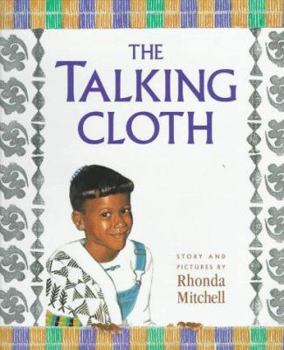The Talking Cloth
Select Format
Select Condition 
Book Overview
Energetic Aunt Phoebe, a collector of life, shows her niece Amber a finely embroidered and hand-printed adinkra cloth from Ghana, which was at one point reserved for royalty. Using her imagination,... This description may be from another edition of this product.
Format:Hardcover
Language:English
ISBN:0531300048
ISBN13:9780531300046
Release Date:March 1997
Publisher:Scholastic
Length:1 Pages
Weight:1.05 lbs.
Dimensions:0.4" x 9.4" x 10.6"
Age Range:4 to 7 years
Grade Range:Preschool to Grade 2
Customer Reviews
2 ratings
Adinkra cloth
Published by Thriftbooks.com User , 17 years ago
A delightful children's book that explains the West African Adinkra cloth and the meanings of the colors and symbols.
A wonderful read on a number of levels
Published by Thriftbooks.com User , 20 years ago
This book is great. I bought it based on the beautiful illustrations and skimming the words, thinking it would be a nice addition to my literacy library for kindergarten. Once I got the book home as usual I first read it to my 2-year-old. Showing a much greater attention span than normal, she listened raptly to the whole thing, viewing pictures, then said, "Again!" The illustrations in this book indeed are a great highlight. They make a reader feel they can step right into the scenes of the story and talk with the people, feel the cloth. Also, the dialogue between the characters is lively, and the story of the adinkra cloth teaches a whole cultural custom from beginning to end. When Amber dreams of being an Ashanti princess, or sees her whole family wearing the cloths as Ashanti people, her imagination is exciting to children, who begin to imagine themselves in different cultures and contexts as well. I like the way the book connected Amber and her family to their cultural traditions in a way that made for an interesting story, but also, provided knowledge about a custom we may not otherwise know. The only thing I do not like about the story, and which continues to give me pause every time I read it to a new child, is the way Aunt Phoebe and Amber's dad's (Phoebe's brother) relationship is portrayed. Amber's dad makes negative comment after negative comment in the book about Aunt Phoebe's collections of cultural heritage, and we have to wait quite long before we learn he really likes drinking mocha and listening to stories too. And we never really learn why this tension exists, so it is just out of nowhere in an otherwise positive story for young children. I feel sensitive to it because in a story of African Americans, to have the only male, the father, being negative about so much for no contextual reason seems to harken back to criticsms I have read about African American males being portrayed in negative roles in literature and film (Color Purple, Waiting to Exhale). With the latter, I think context was there. In this story, since it is for children and very short, if we can't figure out why Amber's dad is unhappy, maybe that part doesn't need to be in an otherwise enriching, positive, and wonderful story.






